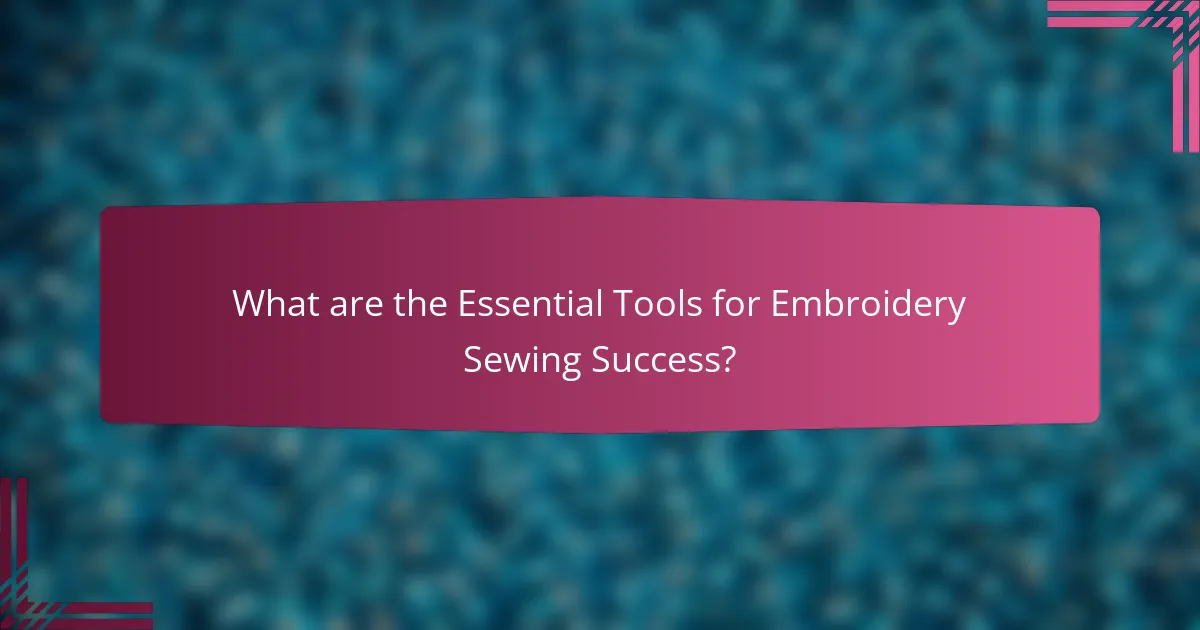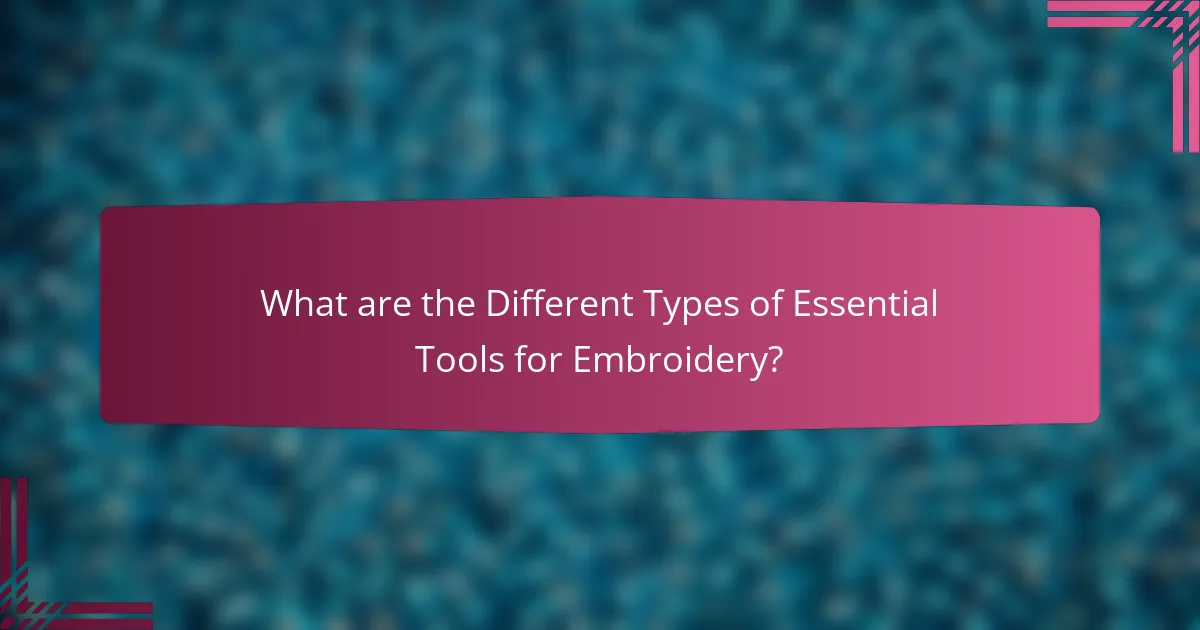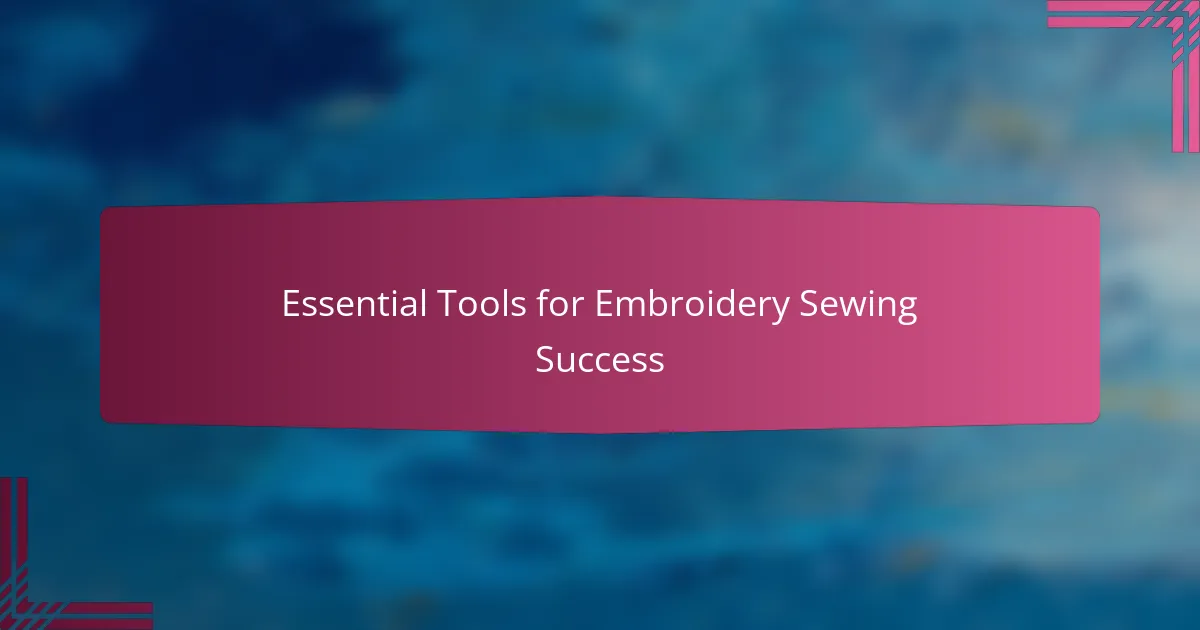
What are the Essential Tools for Embroidery Sewing Success?
Essential tools for embroidery sewing success include an embroidery machine, embroidery threads, stabilizers, and needles. An embroidery machine automates the stitching process, ensuring precision and efficiency. High-quality embroidery threads are crucial for durability and vibrant colors. Stabilizers provide support to the fabric during stitching, preventing puckering. Specific embroidery needles, such as ballpoint or sharp needles, are designed for different fabric types. Scissors for trimming threads and a hoop for keeping fabric taut are also essential. Each tool plays a vital role in achieving professional-quality embroidery results.
How do these tools enhance the embroidery process?
Embroidery tools enhance the embroidery process by improving efficiency, precision, and creativity. Specialized tools like embroidery machines automate stitching, reducing time spent on manual work. High-quality threads provide better durability and color vibrancy, enhancing the overall appearance of the finished product. Stabilizers prevent fabric distortion during stitching, ensuring clean and professional results. Additionally, software tools allow for intricate designs and easy customization, expanding creative possibilities. These enhancements lead to higher quality outcomes and increased satisfaction for both creators and consumers.
What specific features make these tools effective for embroidery?
Effective embroidery tools feature precision stitching capabilities. They ensure accurate designs with minimal error. High-quality needles are essential for penetrating various fabric types smoothly. Adjustable tension settings allow for optimal thread control, preventing breakage or looping. Built-in embroidery designs simplify the process for beginners. User-friendly software enhances design customization and editing. Automatic thread cutters save time and improve efficiency. Lastly, a sturdy frame or hoop secures fabric, maintaining proper tension during stitching. These features collectively enhance the overall quality and efficiency of embroidery projects.
How do the tools contribute to the quality of the finished product?
Tools enhance the quality of the finished product by ensuring precision and consistency in embroidery. High-quality tools, such as sewing machines and needles, enable accurate stitching. They reduce the likelihood of errors, which can compromise the final design. Specialized embroidery hoops keep fabric taut, preventing distortions during stitching. The right thread type and quality influence the durability and appearance of the embroidery. Additionally, tools like stabilizers support the fabric, ensuring clean and professional results. Research indicates that using appropriate tools can improve overall craftsmanship and satisfaction in embroidery projects.
Why is having the right tools important for embroidery success?
Having the right tools is crucial for embroidery success because they directly impact the quality and efficiency of the work. Quality tools ensure precise stitching and better fabric handling. For example, high-quality needles prevent fabric damage and thread breakage. Proper scissors allow for clean cuts and finishing. Additionally, specialized hoops keep fabric taut, which enhances stitch accuracy. Using the right software aids in creating intricate designs easily. Research shows that using appropriate tools can reduce project time by up to 30%. Therefore, investing in the right tools is essential for achieving professional results in embroidery.
What challenges can arise without the proper tools?
Without the proper tools, challenges in embroidery sewing include poor quality work. Inadequate tools can lead to uneven stitches and fabric damage. Lack of appropriate needles may result in skipped stitches or thread breakage. Insufficient lighting can cause eye strain and mistakes in design placement. Missing essential tools like scissors can slow down the workflow. Additionally, not having a proper embroidery machine can limit creativity and efficiency. These challenges can ultimately affect the overall outcome of the project and lead to frustration.
How can the right tools improve efficiency in embroidery projects?
The right tools can significantly improve efficiency in embroidery projects. High-quality embroidery machines can automate stitching, reducing manual labor. Specialized hoops ensure fabric is held securely, preventing distortion during stitching. Digitizing software streamlines the process of creating and editing designs. Access to a variety of thread types can enhance the final product’s appearance and durability. Efficient tools minimize setup time, allowing for quicker project completion. Studies show that using the appropriate tools can reduce project time by up to 30%. Overall, the right tools lead to better quality and faster turnaround in embroidery work.

What are the Different Types of Essential Tools for Embroidery?
Essential tools for embroidery include needles, embroidery hoops, threads, scissors, and stabilizers. Needles are specifically designed for embroidery and come in various sizes. Embroidery hoops hold the fabric taut during stitching. Threads can be made of cotton, polyester, or silk, each offering different finishes. Scissors are essential for trimming threads and fabric edges. Stabilizers provide support to the fabric, preventing distortion during the embroidery process. Each tool plays a vital role in achieving quality embroidery results.
What basic tools are necessary for beginners in embroidery?
Beginners in embroidery need a few essential tools to get started. A basic embroidery hoop holds the fabric taut. Embroidery needles are required for stitching. Thread, specifically embroidery floss, is necessary for creating designs. Scissors are needed for trimming threads. Fabric, such as cotton or linen, serves as the canvas. A marking tool helps outline designs on the fabric. Lastly, a needle threader can assist in threading needles easily. These tools create a solid foundation for beginners to practice and develop their skills in embroidery.
What role does each basic tool play in the embroidery process?
Each basic tool in the embroidery process serves a specific function that contributes to the overall success of the project. Needles are essential for piercing the fabric and carrying the thread through it. Embroidery hoops hold the fabric taut, preventing distortion during stitching. Scissors are used for trimming threads and fabric edges, ensuring a clean finish. Thread provides color and texture, allowing for varied designs and patterns. Marking tools help to outline designs on fabric, guiding the embroiderer during stitching. Each of these tools works together to facilitate the creation of detailed and precise embroidery designs.
How can beginners choose the right basic tools for their needs?
Beginners can choose the right basic tools by assessing their specific embroidery needs. First, they should consider the type of projects they plan to undertake. For instance, simple hand embroidery requires basic needles, threads, and fabric. Next, beginners should evaluate the tools’ quality and durability. High-quality tools enhance the overall experience and results.
Moreover, beginners should research different brands and read reviews to find reliable options. Recommendations from experienced embroiderers can also guide their choices. Additionally, beginners should start with a limited selection of essential tools to avoid overwhelm. As they gain experience, they can expand their toolkit based on their preferences and project complexity. This approach ensures that they invest in tools that truly meet their needs.
What advanced tools can enhance an experienced embroiderer’s toolkit?
Advanced tools that can enhance an experienced embroiderer’s toolkit include digital embroidery machines, software for design editing, and specialized hoops. Digital embroidery machines provide precise stitching and automated patterns. They often come with built-in designs and can handle multiple thread colors. Design editing software allows embroiderers to customize patterns and create unique designs. Specialized hoops ensure fabric stability during stitching, preventing distortion. Additional tools such as thread tension gauges and fabric stabilizers further improve the quality of embroidery work. These tools collectively enhance efficiency and creativity in embroidery projects.
What are the benefits of using specialized embroidery machines?
Specialized embroidery machines enhance efficiency and precision in embroidery projects. They automate stitching processes, reducing manual effort and time. These machines offer a variety of built-in designs and fonts, providing creative flexibility. They also feature advanced technology for accurate thread tension and stitch placement. Many models allow for larger embroidery areas, accommodating bigger designs. Specialized machines often come with user-friendly interfaces for easy operation. They can handle multiple thread colors without frequent changes, streamlining production. Additionally, they typically produce higher-quality stitches compared to standard sewing machines.
How do advanced tools affect the complexity of embroidery designs?
Advanced tools simplify the creation of complex embroidery designs. They offer features like automated stitching, intricate pattern generation, and enhanced precision. These capabilities enable designers to incorporate detailed elements that would be challenging manually. For instance, computerized embroidery machines can handle intricate designs with multiple thread colors seamlessly. Additionally, software tools allow for easy manipulation of design elements, increasing versatility. This technology reduces the time needed for design execution. As a result, the complexity of designs can be elevated without a corresponding increase in effort.

How Can You Maintain Your Embroidery Tools for Longevity?
To maintain your embroidery tools for longevity, regularly clean and oil them. Cleaning removes dust and debris that can affect performance. Use a soft cloth to wipe down surfaces. For metal components, apply a small amount of sewing machine oil. This prevents rust and ensures smooth operation. Store tools in a dry, cool place to avoid moisture damage. Organize tools to prevent wear and tear from friction. Replace worn needles promptly to avoid fabric damage. Regular maintenance extends the life of your embroidery tools significantly.
What are the best practices for cleaning and storing embroidery tools?
To clean embroidery tools, use a soft cloth and mild soap solution. Wipe down surfaces to remove dust and oils. For metal tools, dry immediately to prevent rust. Store embroidery tools in a dry, cool place. Use a dedicated organizer or case to avoid damage. Label compartments for easy access. Keep scissors and blades covered when not in use. Regular maintenance extends the life of tools. Following these practices ensures tools remain in optimal condition.
How does regular maintenance impact the performance of embroidery tools?
Regular maintenance significantly enhances the performance of embroidery tools. It ensures that all components function optimally. Clean tools prevent thread jams and ensure smooth operation. Lubrication reduces friction, extending the lifespan of moving parts. Regularly checking tension settings maintains stitch quality and consistency. Tools that are well-maintained produce more accurate and intricate designs. Neglecting maintenance can lead to decreased efficiency and increased repair costs. Studies indicate that properly maintained machines can improve production speed by up to 20%.
What common mistakes should be avoided when caring for embroidery tools?
Common mistakes to avoid when caring for embroidery tools include neglecting regular cleaning. Dirt and thread residue can accumulate on needles and hoops. This buildup affects the quality of stitching. Another mistake is improper storage of tools. Storing them in damp or unprotected areas can lead to rust or damage. Failing to replace dull needles is also critical. Dull needles can cause fabric snags and uneven stitches. Additionally, using the wrong type of thread can lead to breakage and frustration. Lastly, not using a thread conditioner when necessary can result in tangling and uneven tension. Maintaining these practices ensures longevity and optimal performance of embroidery tools.
What troubleshooting tips can improve your embroidery experience?
Check the needle type and ensure it matches the fabric. A wrong needle can cause thread breakage or fabric damage. Adjust the tension settings on the machine for both the top thread and bobbin. Incorrect tension can lead to puckering or loose stitches. Use high-quality thread to prevent fraying and ensure smooth stitching. Regularly clean the machine to remove lint and debris that can affect performance. Verify that the embroidery hoop is properly secured to avoid shifting during stitching. Test the design on a scrap piece of fabric before starting the final project. This can help identify any potential issues early on.
How can you identify and fix common issues with embroidery tools?
Identify common issues with embroidery tools by examining thread tension, needle condition, and machine settings. Check if the thread is fraying or breaking. This often indicates incorrect tension or a damaged needle. Inspect the needle for bends or dullness. A worn needle can lead to poor stitching quality. Ensure the machine’s settings match the fabric type and thread weight. Incorrect settings can cause skipped stitches or puckering. Regular maintenance, like cleaning lint from the machine, also prevents issues. Following these steps can help maintain optimal performance of embroidery tools.
What resources are available for further learning about embroidery tools?
Books on embroidery techniques and tools are excellent resources. Titles like “Embroidery: A Handbook for Beginners” provide foundational knowledge. Online platforms such as YouTube offer video tutorials on using various embroidery tools. Websites like Craftsy and Skillshare feature courses focused on embroidery skills. Blogs dedicated to sewing often discuss specific tools and their uses. Additionally, forums like Reddit’s r/Embroidery allow for community advice and shared experiences. Local craft stores sometimes host workshops on embroidery techniques and tools. These resources collectively enhance understanding and proficiency in using embroidery tools.
The main entity of this article is the essential tools for embroidery sewing success. The article outlines key tools such as embroidery machines, threads, stabilizers, and needles, emphasizing their roles in enhancing efficiency, precision, and creativity in the embroidery process. It discusses the importance of having the right tools for achieving professional-quality results, the challenges faced without them, and how various tools contribute to the quality of finished products. Additionally, it provides insights on basic and advanced tools, maintenance practices, troubleshooting tips, and resources for further learning about embroidery tools.
